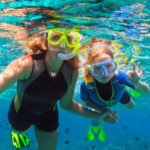Be A Benevolent Visitor Under The Sea
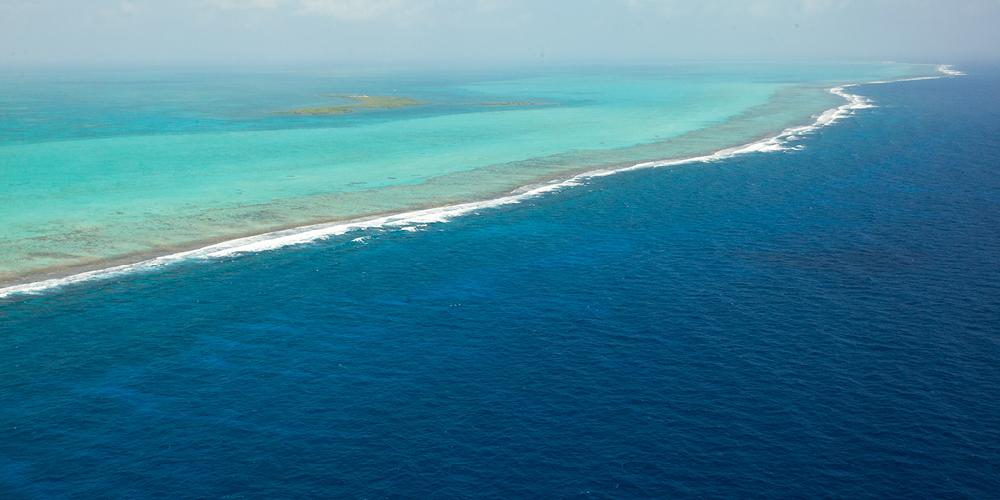
Jun 8, 2018
For most snorkelers and divers, deep respect and love for the sea goes hand-in-hand with the underwater experience. Marine systems can be fragile and by using some common sense and best practices, we can further lighten our “fin print” while underwater. Read on for our best Do’s and Don’ts for underwater sports.
Do not: Chase or otherwise harass the wildlife
Tempting though it may be to entice a moray eel out of its hidey-hole for a better look, hug a nurse shark or swim along with a green sea turtle, resist. A lot of times, this advice is for your safety, as well. Many creatures sting, bite or can otherwise harm you. But more than that, it is out of respect for the very creatures that you are there to see. Lead by example. I cannot tell you how many otherwise amazing YouTube videos of diving or snorkeling are completely ruined for me when the humans in them chase, taunt and touch the wildlife. Such a bummer to see. Let the creatures come to you for a good view, instead of aggressively pursuing them. There is nothing quite like the magic of staying still, focussing on your breath and watching a peaceful manatee swim by.
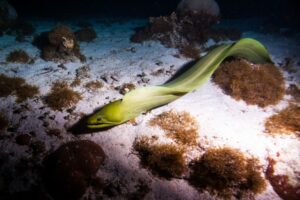
Do: Refrain from collecting anything, dead or alive
Shells, starfish, urchins and sand dollars. All can be seen as nature’s little treasures and at first glance, may make a great souvenir of your dive. However, even bits as unobtrusive as a long-empty shell are integral parts of the marine ecosystem, providing shelter or even a home for different creatures. A great and entertaining testament to this can be found here, watching hermit crabs line up in order of size waiting for a hand-me-down shell to fit their growing size. Many of our snorkel and dive sites fall under protected status which are no-take zones. A reputable guide will be aware of those laws and will include it their briefing.

Do not: Stand or stir up sediment
This might be the one that I see the most often. A lot of times it is with novice snorkelers who are figuring out that it is a different technique than swimming. The problem with standing on the bottom surface or treading water while wearing fins is that you stir up A LOT of sediment. This is bad for several reasons. Even a fine layer of sand and sediment can reduce the photosynthetic efficiency of coral colonies, causing them to die. A more selfish reason to keep sediment safely on the seafloor? It can greatly reduce your visibility when it is stirred up. Lots of creatures lie under the sand as well, if you step on them you risk injury to them and yourself. This also, of course, applies to coral. When diving, this is easily avoidable by correcting your buoyancy. When snorkeling, try floating sideways and kicking gently while you adjust gear or talk to your buddy.
Do: Pick up any trash that you see
Yes, that includes the $20 bill that fell out of somebody’s swim shorts (now that was a lucky dive). Designate one of the pockets in your BCD as your portable trash collector and swim it out. Besides being an eyesore, garbage can pose a serious threat to wildlife who may mistake it as a food source. Looking at the grander scheme of things, do your part in small ways to reduce waste in the first place. A biggie is to be conscious of your use of single-use plastics. Things like straws, water bottles, and plastic bags are all largely avoidable with little to no effort and can have a large impact on our ocean planet.
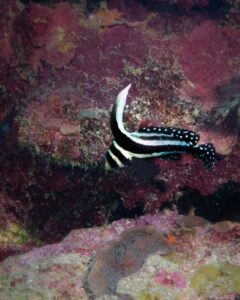
Do not: Feed the wildlife
Feeding ocean critters can make them come to rely on it and also make them aggressive to divers. It is disruptive to their natural feeding patterns and overall affects the sensitive links in the food chain. This also goes for throwing overboard fruit peels or rinds that you snack on post-dive. Nothing gets rid of those salty lips like fresh fruit, but be sure not to slip your banana peel or orange rind into the sea afterward.
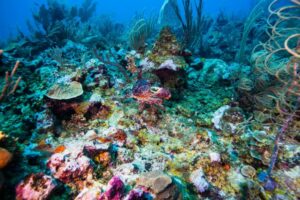
Do: Choose ocean-friendly sun protection
Common ingredients in many sunscreens can bleach coral. Chemicals such as oxybenzone (this is also the culprit for staining your clothes yellow!), butylparaben, octinoxate, and 4-methylbenzylidene camphor are all known coral bleachers. There are quite a few products out there that avoid these culprits but make sure you read the label. Terms like “reef safe” on the packaging are not regulated so it can be meaningless. Better yet, choose to cover up with clothing over chemical sunscreens. Days spent on and in the water can be brutal for your skin, no matter how often you reapply your sunscreen. I often prefer to wear a long rash guard and sometimes even leggings. A trusty towel or sarong can be a lifesaver for your knees and shoulders while on the boat between dive sites. Don’t forget your hat!

To put it simply: Don’t touch anything. If you are to follow just one rule regarding sustainability in the ocean, it is this. I once heard a marine scientist briefing a group of students gearing up for a dive by explaining that we will do far more damage to the marine environment than it will do to us. Barring some extreme encounters, this is mostly true. Tread lightly, enjoy your foray into the sea and literally soak in happiness and calm under the waves.



